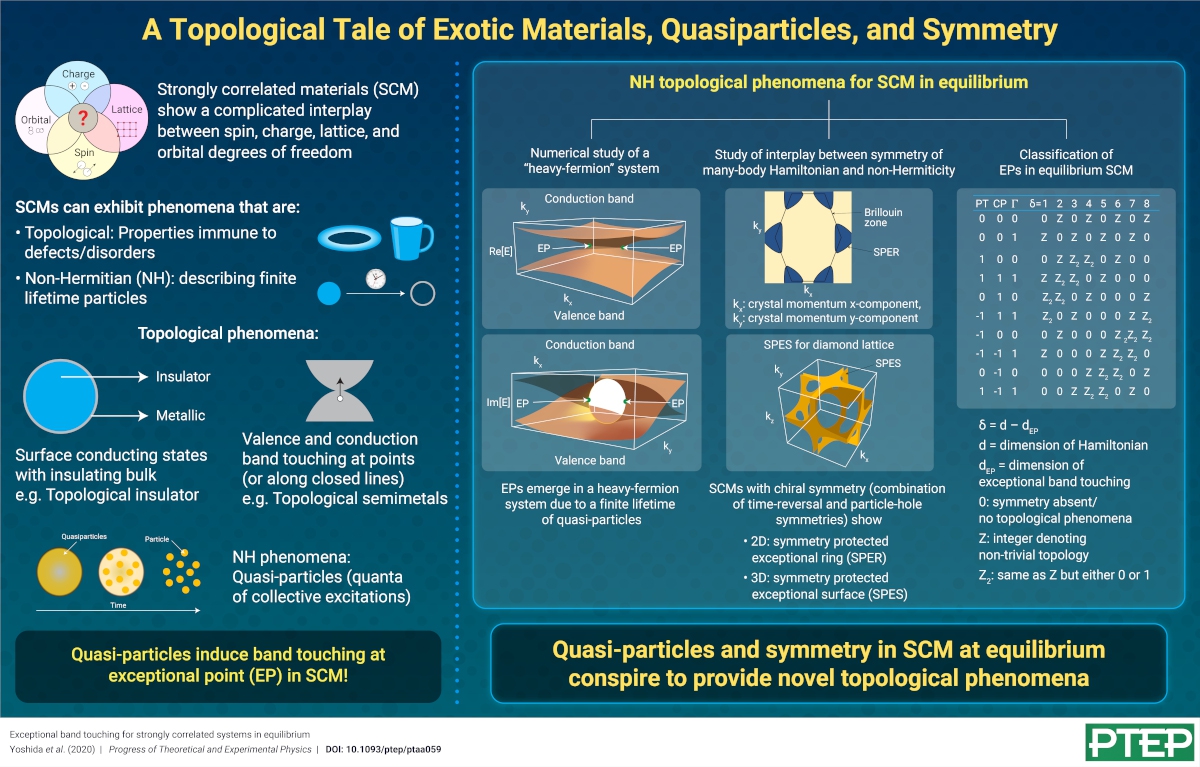Non-real Energies with Real Effects in Exotic Condensed Matter Systems
© The Physical Society of Japan
This article is on
Exceptional band touching for strongly correlated systems in equilibrium
Prog. Theor. Exp. Phys. 2020, 12A109 (2020).
Scientists demonstrate the presence of non-Hermitian topological properties preserved under continuous physical deformations in strongly correlated systems in equilibrium, resulting from short-lived quanta of collective excitations.

Following the discovery of topological matter—or materials characterized by boundary conduction properties that are “topologically protected” (immune to continuous deformations or defects)—there has been a renewed interest in strongly correlated systems—many-body systems showing a complicated interplay between spin, charge, lattice, and orbital degrees of freedom—and their properties, from a topological perspective.
In addition to boundary conduction, topological semi-metals are known to exhibit “topologically protected band touching” in which the valence and conduction bands touch each other at discrete points or along closed loops.
Interestingly, such band touching has recently been extended to non-Hermitian systems, where it is called “exceptional band touching”. Exceptional band touching occurs for non-real energy values, implying that the underlying Hamiltonian is non-Hermitian. From a physical viewpoint, the non-Hermiticity in equilibrium systems is a manifestation of ephemeral “quasiparticles” representing the quanta of collective excitations.
Thus, in this paper, we take stock of the recent advances in non-Hermitian correlated systems in equilibrium, focusing on exceptional band touching in heavy-fermion systems (materials where the effective mass of the quasiparticles is much heavier than free electrons) and correlated systems with chiral symmetry, i.e., systems with the combined symmetry of time-reversal and particle-hole symmetries (electrons and holes feel the same interaction).
We start by demonstrating numerically, using a technique called “dynamical mean-field theory”, that exceptional band touching points appear in a correlated system represented by a non-Hermitian Hamiltonian due to finite lifetimes of quasiparticles. We then move on to correlated systems with chiral symmetry and demonstrate novel structures of exceptional band touching, namely “symmetry protected exceptional rings” (SPERs) and “symmetry protected exceptional surfaces” (SPESs) in two and three dimensions, respectively. Finally, we address a ten-fold way classification of exceptional band touching for a single-particle spectrum, taking into account chiral symmetry, PT symmetry (product of parity and time-reversal symmetry), and CP symmetry (product of particle-hole and parity symmetry).
Our study shows that non-Hermitian properties, typically expected in non-equilibrium systems, can arise even under equilibrium for strongly correlated systems. Moreover, the richer topological physics provided by non-Hermiticity could help solve some of the standing puzzles in condensed matter physics, such as the pseudo-gap of cuprate superconductors and the unusual quantum oscillations in samarium hexaboride (SmB6).
Exceptional band touching for strongly correlated systems in equilibrium
Prog. Theor. Exp. Phys. 2020, 12A109 (2020).
